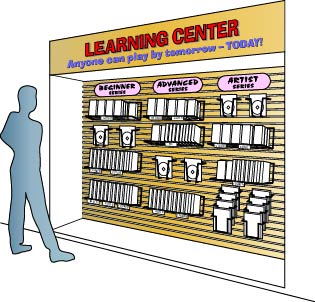




| We want consumers to believe that they can all play an instrument, and that doing so will magically enhance their lives. That’s the ideal. But is it really true? The traditional theory is that in order to play an instrument, a beginner must acquire two new skills: (1) new music language skills, and (2) instrument competency. The Two-Skill Approach: Slow Paced If you have ever studied a foreign language, you know how difficult it is. Many people find that it is beyond their capacity to master even simple skills in another language. And yet, in order to learn how to play an instrument, students are required to learn a new "language" – one that is based on a musical alphabet, which is in turn based on a complex array of formal rules and theory. Before beginners can focus on the instrument and the style of music they want to pursue, they must first learn this new language, and be able to properly "conjugate" musical notes into fundamental scales, chords, and melodies. Learning these new language skills takes time. High school students can study a foreign language for two or three years and still not be able to carry on a simple conversation. Learning a new musical language is no different. Beginning music students can assume that it may be years before they can comfortably "converse" in their new musical language. Music requires two distinctly different skills while other activities in life, such as sports and video games, require participants to learn only one new skill. What would happen if beginning golfers first had to learn a new sports language and theory before they could play? This language would include anatomical concepts that provide insight on how the body muscles work together to perform the swing, as well as physics that would make it possible to analyze how the ball flies through the air and how it is affected by different types of ground surfaces. If learning this new sports language were a prerequisite to learning golf or tennis, there would certainly be far fewer players on the courses and courts today. Unfortunately, unlike sports and video games, beginning musicians can’t just jump in and start learning their instruments. Or can they? Remember the guitar and organ boom of the ’60s and ’70s? Many players didn’t even attempt to acquire the music language skills. They approached music as a "one-skill" learning process. They weren’t concerned with scales, theory, circle of fifths, and so on. They learned chords one song at a time. They learned to play licks by ear. They played the organ with one-note accompaniments and play-by-number melodies. These new rogue players learned from each other and never took a formal lesson. They were having a ball while the rest of us had to sit endlessly practicing scales, having to perfect the presentation of each before moving on to the next.
The focus is on learning the style of music and the songs that they want to play. They can learn a blues riff, a jazz chord progression, or a heavy metal lick during their first session. And even though some music language may be presented, the real focus is on the one-skill instrument learning process. 1) Preview each series. Weed out any products that do not provide instant gratification. Eliminate any that merely mimic one-note-at-a-time book learning, or that begin with elementary songs. Feature only those that teach specific playing styles (blues, jazz, rock, finger-style guitar, metal, etc.). These one-skill learners will not put up with slow-paced learning. They will want to be showing off their skills with the first lick or chord progression that they learn. 2) Divide inventory into groups. Notice that the accompanying illustration shows the Learning Center display divided into three target categories. (1) The Beginner Series must be priced low ($9.95 to 19.95), and teach popular licks, progressions, and songs. As you preview the potential contenders for this section, think "instant gratification." Group these products, as well as those in the other two categories, by instrument. (2) The Advanced Series can be priced higher. Experienced players will be willing to pay more to learn advanced techniques and songs. (3) The Artist Series products are impulse items and must be priced accordingly. When previewing these, remember that your customers want to learn. Eliminate those artists who are merely showing off their playing ability. The Learning Center is not my idea. Louie Munn at Mississippi Music shared it with me earlier this year. I have taken the liberty to fine-tune the presentation. It is important to note that even though the illustration shows the Learning Center as a wall display, it could be built on a Gondola floor rack instead. Just make sure the display is prominent. Add a monitor with a video player next to the display and run continuous sample videos. This will reinforce the fact that your customers will indeed be learning the kind of music they want to play. The second phase of this one-skill learning process would be to install teachers in your studio operations that offer this same one-skill learning beyond the beginning tapes. Don’t forget to include a sign in your Learning Center display to remind them that you have these special teachers. Also, put up a big sign that offers a free video with any instrument purchase. |
|||||
| Back To Top | |||||
 As a music retailer, you should capitalize on today’s videos and interactive CDs. Most contemporary publishers offer them. You probably already have many of these in stock. You may only need to expand the selection and enhance their display. Here’s how:
As a music retailer, you should capitalize on today’s videos and interactive CDs. Most contemporary publishers offer them. You probably already have many of these in stock. You may only need to expand the selection and enhance their display. Here’s how: